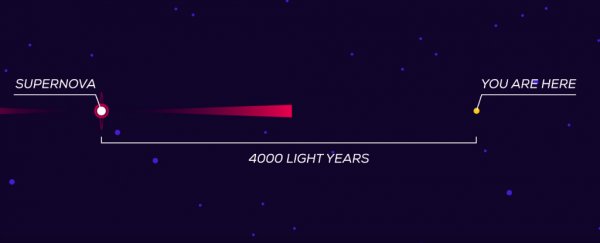The Universe is a beautiful, awe-inspiring place… until you remember that most things in it could end life on Earth. A rogue asteroid, the death of our Sun, and, yep, even a black hole light-years away could easily put an end to life as we know it on our little rocky planet.
As the latest episode of Kurzgesagt explains, black holes can blast out extremely powerful pulses of energy called gamma-ray bursts - or "death from space", as they like to call them - anytime, anywhere, and we just have to hope we're not in the firing line when it happens.
Gamma rays are electromagnetic waves that carry energy, just like visible light. But unlike light, they're much, much more powerful. A single gamma ray photon is more energetic than 1 million visible light photons combined, and is capable of disrupting our DNA.
Thankfully, on Earth, we're shielded from most gamma rays in space by our lovely ozone. But that's only regular gamma rays… gamma-ray bursts, on the other hand, are much more powerful.
You can think about the bursts like gathering the energy from every star within 100 million light-years - so, sucking the energy from thousands of galaxies, each with billions of stars - and then concentrating all of that power into a single laser. That's what a gamma-ray burst is like.
There are two types of gamma-ray bursts that were know about - short and long ones. The long ones last about a minute and are thought to originate from the collapse of a supernova into a black hole. The short ones last only a second, and scientists think they occur when two binary stars merge together to form a black hole.
Both of these scenarios end the same way, though, with a black hole that's surrounded by a magnetised disk of gas left over from its parent star (or stars).
And, as the video above explains, the rotation of that black hole winds up the magnetic field, which funnels hot jets of particles travelling at nearly the speed of light.
The gas inside this funnel creates two extremely focussed jets of gamma rays that erupt out of the black hole like a laser gun.
These gamma-ray bursts are occurring all over the Universe all the time - we detect around one per day on average with NASA's Fermi Gamma-ray Space Telescope. But as far as we know, we've never had one pointing right at us in our cosmic neighbourhood.
Which is good, because if that happened within even a few thousand light-years, a gamma-ray burst would be able to strip our ozone layer away completely, leave the planet - and most complex life - scorched by the Sun's radiation. You need to watch the video above to see that in action.
In fact, that destructive power is the reason that many scientists think we haven't yet seen signs of extraterrestrial life anywhere in the Universe - gamma-ray bursts might be wiping out huge chunks of it regularly.
Most terrifying of all, seeing as gamma-ray bursts travel at the speed of light, one could be heading towards us right now, and we'd never have any warning until it hits us and kills us all. So if you weren't already walking around worrying about your imminent demise, well, now you can.
Have a nice day, everyone.
